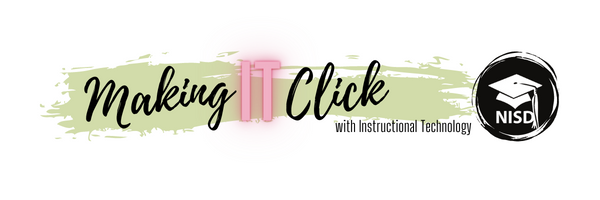When the spring Technology Bingo Challenge was introduced several weeks ago across the district a group of 5th-grade teachers at Sendera Ranch Elementary grabbed their bingo daubers and jumped on board quick, so quick that all four blacked out their bingo board in four weeks. The bingo board contained 25 technology infused challenges which allowed for choice, creativity, job-embedded professional development, and in this case, team collaboration. The unique aspect of this activity is that this team is not self-contained. They are a group of dedicated educators that represent all four core content areas: math, science, social studies, and ELA.
Each teacher knew that participation in this challenge would not only help them to learn how to incorporate technology, but also strengthen their designed lessons. Their favorite tools from the challenge they integrated included Google Draw, Google Maps, Genially, Adobe Spark, and Book Creator. One might ask, what does technology integration mean or look like? Walk into any one of the teachers classrooms at Sendera Ranch and you will see:
- Access to the up-to-date primary source material
- Methods of collecting/recording data
- Collaboration between students and teachers
- Opportunities for expressing understanding of content via multimedia creation
- Learning that is relevant and assessment that is authentic
- Training for publishing and presenting their new knowledge through their eportfolios
Mrs. Gomez stated, “Google Draw allowed students to compare the structures and functions of different species that help them live and survive in a specific environment such as hooves on prairie animals or webbed feet in aquatic animals which is Science TEKS 5.10(A).”
Micah, a 5th grader in Mrs. Gomez’s class points out, “I liked that you get to tell the reader how the animal stays alive and protect themselves in the wild by using icons. This was better than my journal because it was interactive.”
Evy added, “I liked the Google Draw activity because it gave us the freedom to be able to try something new and we were able to decide what we liked or disliked about a new technology platform. It was also a cool way to show facts about an animal.”
In Mrs. Young’s class, Flipgrid facilitated student reflections utilizing the depth and complexity icon of change over time. Flipgrid allowed students to reflect on their learning and think about future goals pertaining to their growth as a learner.
|
Xavier G.
|
Emma W.
|
|
Reagan W.
|
|
Italia G. says, “Flipgrid is fun. It gives you the freedom to say what you want in a fun way because you get to record yourself.”
Lindsey K. says, “I like that you can add sticky notes to write things you want to talk about.”
In Mrs. Swearingen's class, Google Maps has been a great tool used to locate important political features such as the 50 states and capitals, which is TEKS Social Studies 5.7(C). Mrs. Swearingen states, “It goes beyond the flat maps and allows the user to see landforms and the climate of the states and capitals.”
Mrs. Swearingen also has loved Book Creator to have her students create multi-paragraph essays to convey information about a topic, TEKS ELA 5.18A.
Mrs. Stepp’s science classes had a blast completing their HyperDocs on Ecosystems. Students were actively engaged during the work time and loved the many different ways the information was presented: videos, games, blogs, podcasts, etc. One student, Ian, said, “I liked that I could go to different websites and explore what producers, consumers, and decomposers do in an ecosystem. “ His classmate, Ava, added, “I liked that it was self-paced and we could use different websites to learn. I liked how you could watch videos to get information or play games and learn through interacting.”
All four teachers mentioned the students were excited to try new things, especially when they admitted they were not experts with the technology platform. The students loved showing the teachers how to do different challenges with the tools. Mrs. Young stated, “The students were definitely engaged because it was a new way to present information.”
Mrs. Gomez said, “We are a competitive group, but once we started seeing the benefits that these tools brought to our classroom, we continued to try to BINGO. I continued to include our students in the BINGO fun then entire time. When you would walk into the classroom for observation, it was great to see how the teachers were able to share ideas with each other and encourage each other to try new things. Hearing each other say “my students loved this” or “this one was so easy” was motivating and made the teachers want to try MORE! Not only were students exposed to new ways to showcase their learning, but they got several artifacts that could be added and reflected upon into their ePortfolio! Mrs. Young stated, “Students saw me trying new things. They saw me not being afraid to say I don’t have all the answers, would you try and then teach me!”
The challenge has built relationships, provided collaboration, and job-embedded professional development. All in all, the BINGO challenge provided these teachers with just the right resources to provide an authentic and fun learning experience for their students.
This article was written as a collaborative team effort: Mrs. Rene’ Egle - Instructional Technologist, Mrs. Amy Swearingen - SS/ELA, Mrs. Nicole Young - Math/Science, Mrs. Tracie Gomez - Math/Science, and Mrs. Heather Stepp - self-contained. This learning experience supports ISTE Standard for Teachers: (4) Educators dedicate time to collaborate with both colleagues and students to improve practice, discover and share resources and ideas, and solve problems.










No comments:
Post a Comment
Note: Only a member of this blog may post a comment.